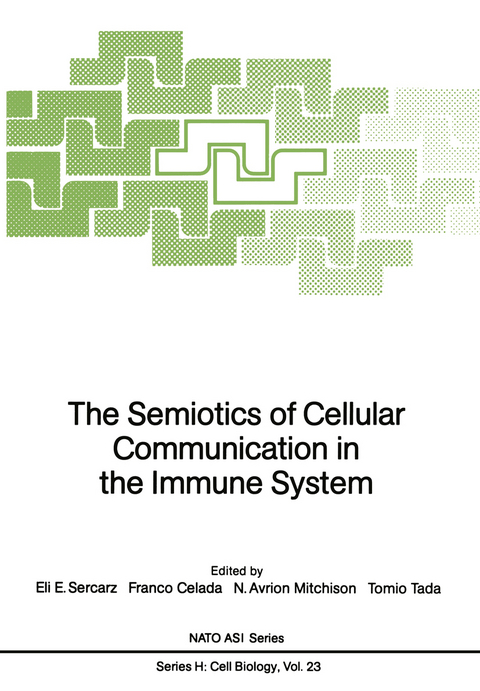
The Semiotics of Cellular Communication in the Immune System
Springer Berlin (Verlag)
978-3-642-73147-1 (ISBN)
This volume contains the contributions to the workshop "The Semiotics of Cellular Communication in The Immune System" which took place at "11 Ciocco" in the hills north of Lucca, Italy, September ~-12, 1986. The workshop was the first meeting of what we hope will be a broad consideration of communication among lymphocytes, and focused on the new interdisciplinary branch of biological sciences, immunosemiotics. It is in the realm of the possible, if not the probable, that in the future a number of scientists larger than the thirty present at 11 Ciocco will find immunosemiotics to fill a need in scientific thinking and a gap between biology and the humanities. This might lead to growth and flourishing of the branch, and in this case the first conference and this first book could be blessed by the impalpable qual ity of becoming "historical", if in an admittedly 1 imited sense. Just in case this should happen the organizers/editors think it wise to set the record straight at this particular time, about the sequen~e of events and circumstances that crystallized the archeology of the "11 Liocco" gathering. They feel a sort of obligation to this endeavor: it has happened all too often that innocent historians have been left in utter confusion by the careless founders of new religions, schisms, revolutions, et cetera, who simply forget to jot down the facts before the whirlwind of time engulfs them in its fog.
Umberto Eco, geboren 1932 in Alessandria, lebte zuletzt in Mailand. Er studierte Pädagogik und Philosophie und promovierte 1954 an der Universität Turin. Anschließend arbeitete er beim Italienischen Fernsehen und war als freier Dozent für Ästhetik und visuelle Kommunikation in Turin, Mailand und Florenz tätig. Seit 1971 unterrichtet eer Semiotik in Bologna. Eco erhielt neben zahlreichen Auszeichnungen den "Premio Strega" (1981) und wurde u. a.1988 zum Ehrendoktor der Pariser Sorbonne ernannt. Er verfasste zahlreiche Schriften zur Theorie und Praxis der Zeichen, der Literatur, der Kunst und nicht zuletzt der Ästhetik des Mittelalters. Seine Romane "Der Name der Rose" und "Das Foucaultsche Pendel" sind Welterfolge geworden. 2011 wurde Umberto Eco mit dem "Premio Pavese" ausgezeichnet und 2014 erhielt er den "Gutenberg-Preis" der Landeshauptstadt Mainz und der Internationalen Gutenberg-Gesellschaft. Er verstarb 2016.
Section I. Semiotics and Immunology: An Introduction.- On Semiotics and Immunology.- A Nonrestrictive Semiotics of the Immune System.- Possible Contribution of Biosemiotics to the Problem of Communication Among Lymphocytes.- A Note on Some Basic Concepts of the Sign.- to Terms Relevant to Immunological Recognition.- Section II. Conceptual Debt of Semiotics to Immunology.- Signs and Codes in Immunology.- Semiosis for the Immune System But Not the Immune Response or What Can Be Learned About Language by Studying the Immune System?.- Does the Human Mind Use a Logic of Signs Developed by Lymphocytes 108 Years Ago?.- Section III. General Aspects of Communication Within the Immune System.- Contexts in the Cellular Communications: How the Mobile Cells Recognize Right Partner Cells to Talk With?.- Structure and Direction of Message in the Immune Network and Circuits.- Modes of Communication Within the Immune System: Action or Reaction?.- Section IV. Intermezzo.- Of Words, Genes and Music.- Section V. Organizational Patterns, and the Origin of Meaning.- Structural Coupling and the Origin of Meaning in a Simple Cellular Automation.- The Control of T Lymphocyte Activity May Involve Elements of Semiosis.- Digital Processing and Immuno-Regulatory Circuits.- Section VI. Self-Referential and Autonomous Nature of Immune System.- Observer, Immune System and Their Respective Objects (About Self - Non-Self Discrimination).- General Principles of Complex Biological Systems Operating in Immunology. Self-Response Might Define the Boundaries of the Developing Immune System.- Towards Cognitive Immunology: G.O.D. is Infinite.- Parasites and the Immune Response: Crossing the Signals.- Section VII. The Creation of Signs and the Language of Immune Interaction.- Grammars, Machines, andImmunoregulatory Cell Interactions. An Exercise in Immunosemiotics.- Is There a Unique Language in the Immunoregulatory System?.- Recognition of Syngeneic Forms of L-Chain V-Region Peptides by T Helper Cells Suggests that B Cell Antigen Receptors are Processed and Reutilized in Cognate T-B Interaction.- Section VIII. Cellular Connectivity and Suppression.- Regulatory T Cell Function, Antigen Recognition, and an Immunological Decision Point.- On I-J, a Network Centre Pole and AIDS.- Immune Suppression: An Integral Property of the Immune System?.- Section IX. Choices and Decisions.- Signs and Meaning in the Study of the Immune and Higher Nervous System.- Whither the Immune Response? Factors Directing the Response to Humoral or Cell-Mediated Immunity.- Immunoschismatics: Who is Guilty of Original Antigenic Sin?.- Epitypic-Idiotypic Dominance as an Evolutionary Answer to the Intercellular Communication Problem.
| Erscheint lt. Verlag | 16.12.2011 |
|---|---|
| Reihe/Serie | Nato ASI Subseries H: |
| Illustrationen | Umberto Eco |
| Zusatzinfo | XI, 335 p. |
| Verlagsort | Berlin |
| Sprache | englisch |
| Maße | 170 x 244 mm |
| Gewicht | 614 g |
| Themenwelt | Medizin / Pharmazie ► Medizinische Fachgebiete ► Dermatologie |
| Studium ► Querschnittsbereiche ► Infektiologie / Immunologie | |
| Naturwissenschaften ► Biologie ► Zellbiologie | |
| Schlagworte | Activation • AIDS • Antigen • Biology • Cell • immune response • immune system • immunity • immunology • Lymphocytes • parasite • Parasites • T Cell |
| ISBN-10 | 3-642-73147-3 / 3642731473 |
| ISBN-13 | 978-3-642-73147-1 / 9783642731471 |
| Zustand | Neuware |
| Haben Sie eine Frage zum Produkt? |
aus dem Bereich


